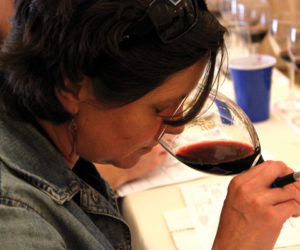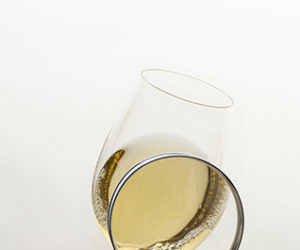
Dear Wine Wizard, I’ve been making wine for about a year now and I’m wondering if you’d be willing to help me out with a wrap-up of some of your winemaking wisdom. What are your top five rookie mistakes to avoid in winemaking?
Jennifer Scott
Brooklyn, New York
Wine Wizard replies: That’s a great request. Sometimes I forget to really distill what I believe when it comes to fine winemaking. Just like anything in life, having a concentrated, bullet-pointed list of the essence of a thing is very important. It can guide us in times of challenge and inspire us to make even better wines. So here goes:
Top five rookie mistakes:
- Picking too early or too late: I can’t say this enough — it all starts with the raw material. Pick too early and your Cabernet will never lose that nasty green bell pepper aroma. Pick too late and your delicate Malvasia Bianca will be a flabby, high pH flop with 15.0% alcohol. Making the pick call is the single most important decision a fresh grape winemaker will make in a wine’s life — be sure you make it right. Do be informed by analysis (Brix, pH and TA) but even more important, use your taste buds. If you’re a home winemaker getting someone’s second crop, try to let it hang on the vine as long as you can to lose some of that acid and get to the flavor profile you’re looking for. If you’re making wine with a kit, buy the very best quality you can.
- Inappropriate must adjustment: Acid, water, enzymes, nutrients, tannins, bentonite, sulfur dioxide. The list of things we can add to our freshly-crushed grapes is too long to enumerate. Many beginning winemakers believe that the more “tweaks” and additions they make, the better their wine will be. I try to keep my winemaking minimalist and think about using additives only when the grapes really call for it. The idea is to get such good grapes that you don’t have to add anything at all if you don’t want to.
- Not understanding the destructive power of oxygen and spoilage microbes: After the carbon dioxide from the primary and secondary fermentation blows off, your wine is vulnerable to attack by oxygen and spoilage yeast and bacteria. Leaving wine uncovered, untopped or unprotected by insufficient sulfur dioxide is asking for trouble. When a wine is actively fermenting it can be roughed up, left uncovered and moved around without much worry. Once a wine goes still it’s critical to protect it.
- Not understanding the constructive power of oxygen and good microbes: Believe it or not, oxygen is critical for a wine’s early development. A healthy fermentation actually needs oxygen to perform its best and young wines, especially, can benefit from an aerative racking in the first months of life. Good microbes like yeast and certain strains of lactic acid bacteria are your partners in the fine winemaking process. Learn about how to use these tools to your advantage and to actively manage their interactions with your wine.
- Keeping inadequate records: So much in winemaking seems to happen by chance — the weather influences the grapes, a cold cellar can slow down a fermentation and a random spoilage yeast can invade a perfectly good wine. To maximize the level of control you have over your wines, keep good records during the winemaking process. Only by logging in dates, treatments, wine analysis and tasting notes do we learn what works, what doesn’t and how to improve.

Dear Wine Wizard, I’m just getting started with winemaking and am looking for some general advice, perhaps a short list of the most important things to remember. Perhaps you could share your wisdom with me and offer some essential winemaking rules?
Terry Brennan Cambridge, New York
Wine Wizard replies: Hmm . . . this is a good question and one that more people should ask when getting into a hobby. It also serves as a natural follow-up to my previous mistakes answer. It is good to look at the total picture of winemaking and focus in on the most important elements. These are the rules that come to mind:
- It all starts with the raw material: This is rule #1. Your wine will only be as good as your starting material. It’s possible to make good wine out of great fruit but you can’t make great wine out of mediocre fruit. An ancillary rule is that you’ve got to understand and accept your starting material, both its potential and its limitations. You can ferment with the latest yeast, stir the lees and use an expensive French oak barrel, but an insipid wine can’t grow beyond its roots, even with all the expensive and time-consuming treatments in the world.
- Acid is the foundation of wine: I learned this at my first-ever winemaking job as a cellar rat at Chalone Vineyards near Monterey, California. Even in the blasting 100-degree days the incredible limestone soils and the chilly nights kept the acid levels in the Pinot Noir and Chardonnay much higher than one would expect. This is one of the secrets to the long ageability of Chalone’s wines — they are rich in natural grape acids, modest in alcohol and rooted in what I would call one of California’s only true terroir vineyards. Sugar is only important in determining the final alcohol content. Fine wines should be picked and made with the true focus being on the pH, TA and flavor/tannin/texture balance of the acids.
- Learn the science behind the art: Don’t just blindly follow a recipe that says to add 30 ppm sulfur dioxide. Take classes, study on the web, learn from experienced winemakers, do whatever you can to learn why you add that 30 ppm sulfur dioxide. More importantly, you should know when to add 30 ppm, when to add 50 ppm and when to add none at all. Knowledge and experience will allow you to be guided by what the wine needs and not by what someone tells you it does.
- Listen to your wine: Let the wine tell you what it needs and where it wants to go. Your winemaking buddies, current style trends and, for the commercial winemaker, market pressure can all lead winemakers to use too many new barrels, leave a little residual sugar or bottle too soon. Once the grapes are picked, the path the wine needs to take is already laid out before you. A super-corpulent 30 ºBrix Syrah would have a hard time squeezing itself into the bottle as a crisp, light Syrah rosé. Such ripe, luscious fruit really wants to be the base for a stellar Port-style dessert wine. Don’t force it. Go where the wine leads you.
- Don’t take wine, or yourself, too seriously: Even those of us who make wine as our day job need to remember that wine is, at its core, supposed to be fun. Whether it’s touring wine country with your sweetheart, watching Lucy and Ethel stomping messily away or bringing out a bottle of your finest for the backyard bocce ball team, wine heightens our enjoyment of everyday life, links us to the past and connects us to the natural world in a very tangible way.






